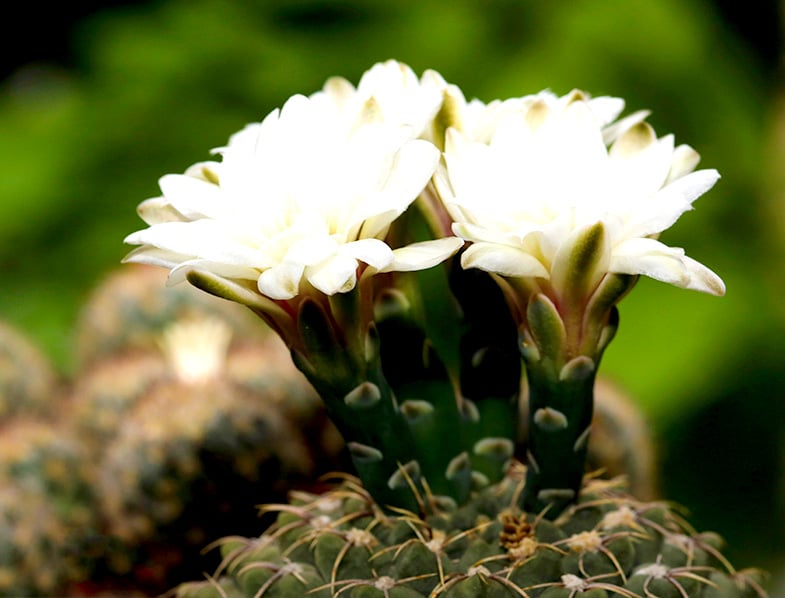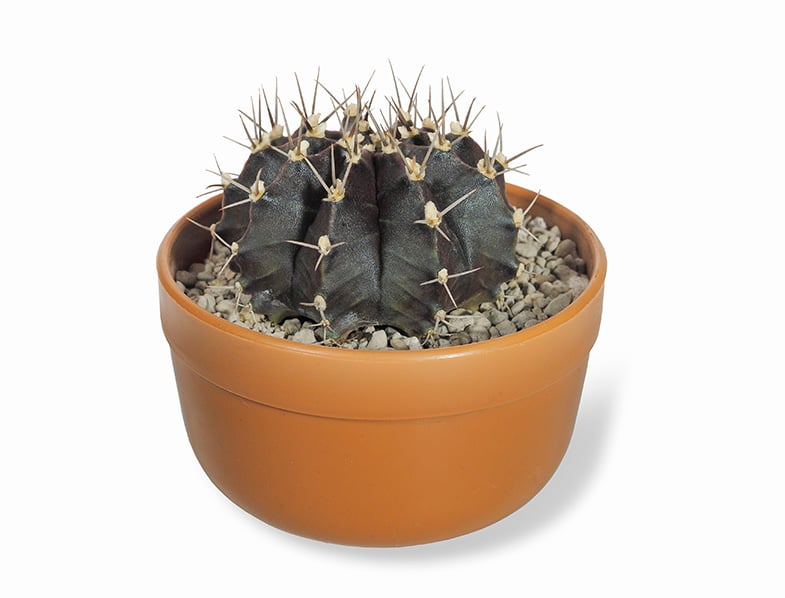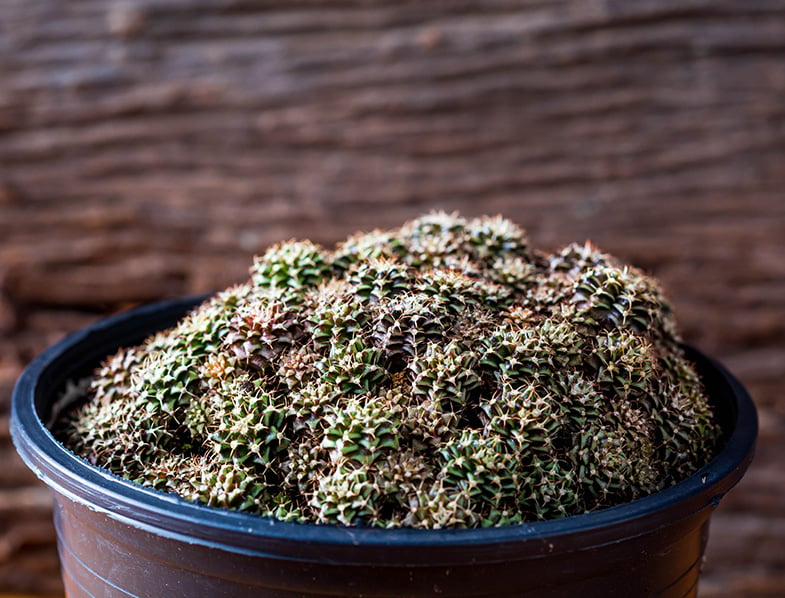With so many species to choose from, choosing the perfect cactus can be a challenge. The good news is that all cacti are perfect and Chin cacti make no exception. So they must have a special place in your cacti collection!
Chin cacti are not only very good-looking, but they are also easy to grow and care for. With their alluring shapes and hypnotic flowers, these cacti work well as ornamental houseplants indoors on windowsills, desks, coffee tables, or even bookshelves.
Gymnocalycium, commonly referred to as Chin cactus, is a species of flowering cacti in the Cactaceae family. Chin cacti are native to several countries of South America, such as Argentina, Paraguay, southern Bolivia, and parts of Uruguay and Brazil.
These cacti are more popular than you would expect! Did you ever hear about the Moon cacti? They are a superb grafted specimen between two adorable cacti that melted many gardeners’ hearts. And guess what! The top cactus is a Gymnocalycium Mihanovichii, a chubby and colorful companion that gives mild headaches to their owners. But all cacti deserve attention and we are here to support and love them unconditionally!
About Chin Cactus
- Their genus name “Gymnocalycium” is the Greek for “naked calyx”. This description refers directly to their flower buds that bear no spines or hair.
- Chin cacti prefer bright, but indirect or filtered sunlight all-year-round. Too much extreme sunlight may damage your cacti, resulting in blooming failure.
- Unless you live in a warm region, these cacti are suitable only for growing them indoors. They need extra protection from extreme temperatures, especially frost conditions.
- If the temperatures drop below 50 °F (10 °C), Chin cacti must be placed under glass and cultivated with proper heat.
- Their potting soil must be well-draining and gritty, such as those commercial mixes that are specifically designed for cacti and succulents. They require fertilizers only when the growth is too slow.
- Gymnocalycium cacti have a shallow root system that is very sensitive to over-watering. Due to their tolerance of drought, it is always better to provide your cacti with less water than needed.
- There are no toxic effects reported for Chin cacti. They can be grown in the proximity of curious pets and children, however, their spines can be a bit dangerous.

Chin Cactus Features: An Overview
- The Gymnocalycium genus contains about 70 species of cacti. Several popular species are highly cultivated as houseplants, such as G. Baldianum, G. Mihanovichii, G. Eurypleurum, and G. Bruchii.
- Chin cacti species exhibit a large diversity in appearance, with various shapes, dimensions, and colors.
- They are dwarf cacti that can reach 7 inches (16 cm) in height and 12 inches (30 cm) in diameter. However, most species grow between 2 and 6 inches (4-15 cm) tall.
- Unlike other species of cacti, their stem and flowers come without any spines or wool. The white spines can be found only on the main plant and they flatten and hug the ribbed plant.
- Chin cacti have gained their reputation as houseplants due to their easy blooming habits. Generally, their lovely flowers are pretty large for these small cacti and come in very bright shades of pink, red, white, or salmon.
- Although they are pretty hardy plants, these cacti can be occasionally bothered by mealybugs or spider mites. The white fungus can also be a problem for them.
- Thanks to their tiny dimensions, Chin cacti can make for a great companion to succulents and other species of cacti. They all are perfect for pot-growing indoors.

Growing Chin Cactus
Although Chin cacti do not have identical necessities as other more ordinary species of cacti, they are not a big challenge and can be grown and cared for by any type of gardener. Once you pay attention to their particular demands, these cacti will not cause any trouble. With a suitable environment and lots of love, you and your plants will have an excellent and long-lasting friendship.
Light-wise, Chin cacti do well in bright locations that provide them with plenty of filtered light. For outdoor growing, place your cacti in filtered light or partial shade during the summer.
If you grow your cacti indoors near a sunny window, make sure you protect them from direct sunlight using sheer curtains.
The ideal spots to grow them indoors are east or south-facing windows where they can be exposed to at least 4 to 6 hours of morning sun and some shade in the afternoon. When the winter has settled in, the light intensity might not be as preferred. You can also use artificial fluorescent light to increase the quality and control the quantity of light your cacti receives.

When it comes to temperatures, these cacti prefer to grow in warmer conditions above 60 °F (15 °C). Somehow, they can tolerate short periods of frost with temperatures between 15 and 50 °F (-9.4-10 °C). If you live in a region with harsh winters, it is suggested you keep your Chin cacti indoors all-year-round.
Like all cacti, they will show the best growing results if they are planted in light, porous, and well-draining soil. When first planting your Chin cacti, combine their potting soil with perlite to improve drainage. Many gardeners use a standard commercial mix that is suitable for cacti and succulents. You can also make your own potting soil by mixing coarse sand, potting mix, and perlite.
During their active growing period, your Chin cacti may need some fertilizing. Feed them with good-quality cactus food in late spring. If your cacti are vigorous and show visible growth, you can skip fertilizers until the next year.
Chin cacti do no require repotting very often, as they can remain in the same container for years. They grow at a pretty slow pace, so their roots will not feel crowded with time. When your cacti start to outgrow their growing medium, replace it with a pot that is one size larger than the current one. Gently remove your cacti from their container, remove any excess soil, and transplant them into their new pot that is filled with a fresh cactus mix.
Watering Chin Cactus
As long as you are growing Chin cacti in proper well-draining soil, watering them will be a piece of cake. A really important detail regarding this process is that you will always need to check the soil before watering your cacti again. When the soil feels dry to the touch and their pot is very easy to lift, then you will know for sure that your cacti are thirsty.
Have you forgotten about watering your cacti? No worries! Most cacti are tolerant of drought, storing large amounts of water into their body, and Chin cacti are no different. They are, however, very sensitive to over-watering and susceptible to root rot. When you provide these cacti with too much water, they become soft, bendy, and eventually die off.
They usually need regular watering once every one or two weeks during the summer. If you live in a region with hot and dry climates, it may be necessary to provide your cacti with more frequent watering. When the temperatures are cooler or the frosty winter has shown its face, you can skip the watering.
Humidity-wise, Chin cactii do well in rooms that tend to have dry rather than humid air. You can bring the humidity around your cacti at ideal levels by placing them near air vents or using a dehumidifier.

Propagating Chin Cactus
One common way to propagate these adorable cacti is through harvesting their seeds. This method is one of the easiest and safest way of making more Chin cacti. They can be placed anywhere around your house or used as a gift for a beloved one.
These cacti will respond well to propagation if their seeds are cultivated in early spring. Thanks to warmer temperatures, the seeds will germinate faster and will show the best results when proper care is provided. Fill a container with fresh cactus mix and plant the seeds into it. Place the pot in a sunny location and water the seeds regularly to keep the soil moist. This process will require a patient gardener, as it is not as efficient as other propagation methods.
Several Chin cacti species can also be propagated by cuttings including G. Baldianum or G. Damsii. The mother cacti send out tiny offsets that can be used very easily in propagation. Wait for the offsets to grow and to develop well for optimal results. Carefully remove the offsets from the mother plant and allow them to dry out for a few days. Once they have dried completely, dip the cuttings in rooting hormone, plant them into fresh potting soil, and give them the usual care as for a mature plant.
In Conclusion
No matter how many cacti you already have, there is always room for more! If you want to grow Chin Cacti, you should know that they are pretty, low-maintenance, and most of them will forgive your mistakes.
Chin cacti have all these traits and make for a great lifetime companion as long as their environment mimics their natural habitat. Moreover, as a thank you for your efforts and unconditional love, these beauties will exhibit gorgeous flowers that will bring a nice dash of color into your surroundings.

1 Comment
Very informative article..
Simple and easy to understand.
Thank you !